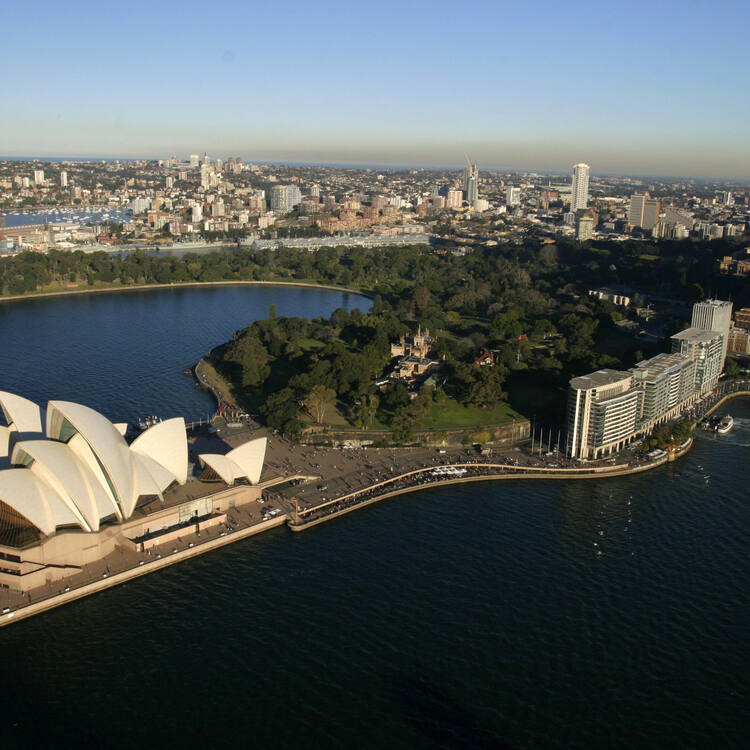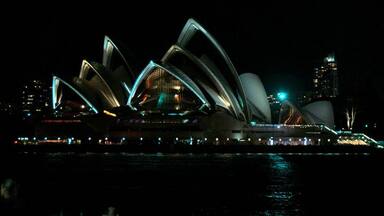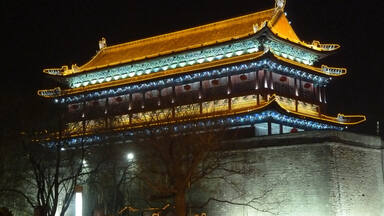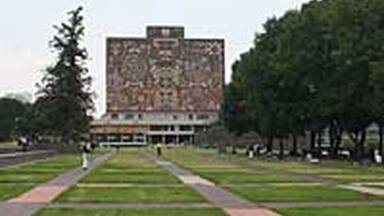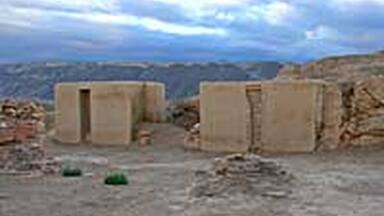Sydney Opera House
Sydney Opera House
Inaugurated in 1973, the Sydney Opera House is a great architectural work of the 20th century that brings together multiple strands of creativity and innovation in both architectural form and structural design. A great urban sculpture set in a remarkable waterscape, at the tip of a peninsula projecting into Sydney Harbour, the building has had an enduring influence on architecture. The Sydney Opera House comprises three groups of interlocking vaulted ‘shells’ which roof two main performance halls and a restaurant. These shell-structures are set upon a vast platform and are surrounded by terrace areas that function as pedestrian concourses. In 1957, when the project of the Sydney Opera House was awarded by an international jury to Danish architect Jørn Utzon, it marked a radically new approach to construction.
Description is available under license CC-BY-SA IGO 3.0
Opéra de Sydney
Inauguré en 1973, l’Opéra de Sydney fait partie des œuvres architecturales majeures du XXe siècle. Il associe divers courants innovants tant du point de vue de la forme architecturale que de la conception structurelle. Sculpture urbaine magnifique soigneusement intégrée dans un remarquable paysage côtier, à la pointe d’une péninsule qui s’avance dans le port de Sydney, cet édifice exerce depuis sa construction une grande influence sur le monde de l’architecture. L’Opéra de Sydney se compose de trois groupes de « coquilles » voûtées et entrelacées qui abritent les deux principaux lieux de représentation et un restaurant. Les « coquilles » disposées sur une vaste plate-forme sont entourées de terrasses qui font office de promenades piétonnes. En 1957, la décision prise par un jury international de confier la réalisation de l’Opéra de Sydney à l’architecte danois Jørn Utzon, a symbolisé la volonté d’adopter une démarche radicalement nouvelle en matière de construction.
Description is available under license CC-BY-SA IGO 3.0
دار الأوبرا، سيدني
جرى افتتاح دار الأوبرا في سيدني عام 1973، وأدرج هذا الصرح بوصفه عملاً هندسياً رائعاً للقرن العشرين. فهو يشمل جوانب إبداعية ومبتكرة عدة على صعيد الهندسة المعمارية والتصميم. بنية حديثة كبرى في مشهد بحري، على طرف شبه جزيرة مطلة على مرفأ سيدني، تركت أثراً كبيراً ولفترة طويلة على الهندسة المعمارية. يشمل مبنى دار الأوبرا ثلاث مجموعات من "الأصداف" المتشابكة التي تؤوي قاعتي أداء رئيسيتين ومطعماً. وتحيط بالبنية ممرات للمشاة. أوكلت لجنة تحكيم دولية، عام 1957، مهمة إنجاز مشروع دار الأوبرا في سيدني إلى المهندس المعماري الدنماركي جورن أوتزون، ولم يكن معروفاً آنذاك، فأنشأ نهج بناء مستحدثا تماماً وقائما على مبدأ المشاركة. وتعترف لجنة التراث العالمي من خلال إدراج هذا المبنى بدار الأوبرا في سيدني كصرح فني أخاذ ومفتوح أمام المجتمع ككل.
source: UNESCO/CPE
Description is available under license CC-BY-SA IGO 3.0
悉尼歌剧院
落成于1973年的悉尼歌剧院是20世纪的伟大建筑工程之一,无论是在建筑形式上还是在结构设计上,都是各种艺术创新的结晶。在迷人海景映衬下,一组壮丽的城市雕塑巍然屹立,顶端呈半岛状,翘首直指悉尼港。这座建筑给建筑业带来了深远的影响。歌剧院由三组贝壳状相互交错的穹顶组成,内设两个主演出厅和一个餐厅。这些贝壳状建筑屹立在一个巨大的基座之上,四周是露台区,作为行人汇集之所。1957年,国际评审团决定由当时尚不出名的丹麦建筑师丁·乌特松(Jørn Utzon) 设计悉尼歌剧院项目,标志着建筑业进入了全新的合作时期。悉尼歌剧院作为向全社会开放的伟大艺术杰作列入了《世界遗产名录》。
source: UNESCO/CPE
Description is available under license CC-BY-SA IGO 3.0
Сиднейский оперный театр
Сиднейский оперный театр был открыт в 1973 году. Это - одно из выдающихся архитектурных сооружений XX в., в котором гармонично переплелись различные новаторские направления искусства и архитектуры, отразившиеся как на форме здания, так и на его конструкторском решении. Городское скульптурное сооружение, построенное на мысе полуострова в Сиднейском заливе, прекрасно вписывается в пейзаж океанского побережья и уже на протяжении многих лет оказывает большое влияние на современную архитектуру. Здание оперы состоит из трех соединенных между собой "раковин", в которых размещаются основные залы для спектаклей и ресторан. Эти "раковины" лежат на широком основании, где обустроены прогулочные террассы и скверы. В 1957 году, когда международное жюри доверило строительство Сиднейской оперы датскому архитектору Йорну Утсону, это решение символизировало радикально новый подход к вопросам градостроительства.
source: UNESCO/CPE
Description is available under license CC-BY-SA IGO 3.0
Ópera de Sidney
Inaugurada en 1973, la ópera de Sidney es una de las obras arquitectónicas más importantes del siglo XX. Su edificio es todo un compendio de múltiples corrientes creativas e innovadoras, tanto en lo que respecta a sus formas arquitectónicas como en lo referente a su diseño estructural. Asentada en un paisaje marítimo excepcional, al extremo de una península prominente que se adentra en el puerto de Sidney, esta grandiosa escultura urbana ha ejercido una influencia perdurable en la historia de la arquitectura. El edificio está compuesto por tres grupos de “valvas” abovedadas y entrelazadas que albergan las dos salas principales de espectáculos y conciertos, así como un restaurante. Esta estructura en forma de valvas se asienta en una vasta plataforma, rodeada de amplias terrazas, que cumplen la función de paseos peatonales. Fue en 1957 cuando un jurado internacional adjudicó al arquitecto danés Jørn Utzon la ejecución del proyecto, que se caracterizó por un planteamiento radicalmente nuevo de la construcción.
source: UNESCO/CPE
Description is available under license CC-BY-SA IGO 3.0
シドニー・オペラハウス
source: NFUAJ
Sydney Opera House
Source: unesco.nl
Outstanding Universal Value
The Sydney Opera House constitutes a masterpiece of 20th century architecture. Its significance is based on its unparalleled design and construction; its exceptional engineering achievements and technological innovation and its position as a world-famous icon of architecture. It is a daring and visionary experiment that has had an enduring influence on the emergent architecture of the late 20th century. Utzon's original design concept and his unique approach to building gave impetus to a collective creativity of architects, engineers and builders. Ove Arup's engineering achievements helped make Utzon's vision a reality. The design represents an extraordinary interpretation and response to the setting in Sydney Harbour. The Sydney Opera House is also of outstanding universal value for its achievements in structural engineering and building technology. The building is a great artistic monument and an icon, accessible to society at large.
Criterion (i): The Sydney Opera House is a great architectural work of the 20th century. It represents multiple strands of creativity, both in architectural form and structural design, a great urban sculpture carefully set in a remarkable waterscape and a world famous iconic building.
All elements necessary to express the values of the Sydney Opera House are included within the boundaries of the nominated area and buffer zone. This ensures the complete representation of its significance as an architectural object of great beauty in its waterscape setting. The Sydney Opera House continues to perform its function as a world-class performing arts centre. The Conservation Plan specifies the need to balance the roles of the building as an architectural monument and as a state of the art performing centre, thus retaining its authenticity of use and function. Attention given to retaining the building's authenticity culminated with the Conservation Plan and the Utzon Design Principles.
The Sydney Opera House was included in the National Heritage List in 2005 under the Environment Protection and Biodiversity Conservation Act 1999 and on the State Heritage Register of New South Wales in 2003 under the Heritage Act 1977. Listing in the National Heritage List implies that any proposed action to be taken inside or outside the boundaries of a National Heritage place or a World Heritage property that may have a significant impact on the heritage values is prohibited without the approval of the Minister for the Environment and Heritage. A buffer zone has been established.
The present state of conservation is very good. The property is maintained and preserved through regular and rigorous repair and conservation programmes. The management system of the Sydney Opera House takes into account a wide range of measures provided under planning and heritage legislation and policies of both the Australian Government and the New South Wales Government. The Management Plan for the Sydney Opera House, the Conservation Plan and the Utzon Design Principles together provide the policy framework for the conservation and management of the Sydney Opera House.
Links
-
Weibo account
-
YouTube account
-
Twitter account
-
Facebook page
-
 View photos from OUR PLACE the World Heritage collection
View photos from OUR PLACE the World Heritage collection
-
The Official Site for Australian Travel and Tourism Australia
-
Sydney Opera House (Department of Sustainability, Environment, Water, Population and Communities )
-
New South Wales Heritage Office
-
Official website page (in English only)
